
Little Fugitive is a 1953 American independent drama film co-written and co-directed by Raymond Abrashkin, Morris Engel, and Ruth Orkin, which tells the story of a child alone on Coney Island. It stars Richie Andrusco as the title character, and Richard Brewster as his older brother. The film was screened at 14th Venice International Film Festival, where it was awarded the Silver Lion, and nominated for Best Writing, Motion Picture Story, at the 26th Academy Awards.
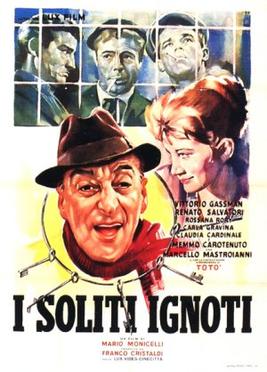
Big Deal on Madonna Street is a 1958 Italian comedy caper film directed by Mario Monicelli. Regarded as one of the masterpieces of Italian cinema, the film received an Academy Award nomination for Best Foreign Language Film.

Francis Bosley Crowther Jr. was an American journalist, writer, and film critic for The New York Times for 27 years. His work helped shape the careers of many actors, directors and screenwriters, though his reviews were criticized as unnecessarily harsh. Crowther was an advocate of foreign-language films in the 1950s and 1960s, particularly those of Roberto Rossellini, Vittorio De Sica, Ingmar Bergman, and Federico Fellini.

Dark City is a 1950 American film noir crime film starring Charlton Heston in his Hollywood debut, and featuring Lizabeth Scott, Viveca Lindfors, Dean Jagger, Don DeFore, Ed Begley, Jack Webb and Harry Morgan. It was produced by Hal B. Wallis and directed by William Dieterle.
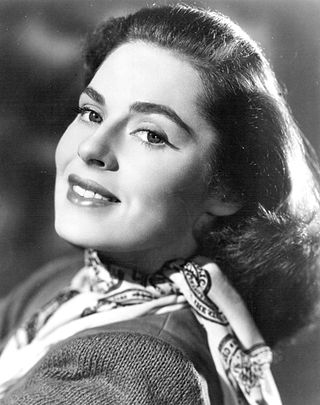
Elsa Viveca Torstensdotter Lindfors was a Swedish American stage, film, and television actress. She won an Emmy Award and a Silver Bear for Best Actress.
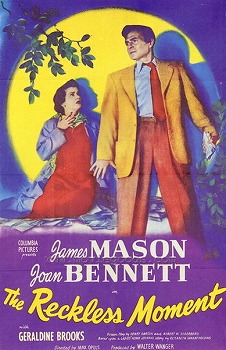
The Reckless Moment is a 1949 American film noir melodrama directed by Max Ophüls, produced by Walter Wanger, and released by Columbia Pictures with Burnett Guffey as cinematographer. It starred James Mason and Joan Bennett. The film is based on The Blank Wall (1947), a novel written by Elisabeth Sanxay Holding. The 2001 film The Deep End is a remake based on the same source material.

Scandal Sheet is a 1952 American film noir directed by Phil Karlson. The film is based on the novel The Dark Page by Samuel Fuller, who himself was a newspaper reporter before his career in film. The drama features Broderick Crawford, Donna Reed and John Derek.
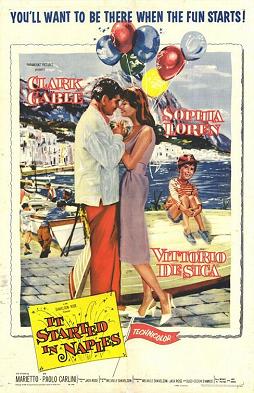
It Started in Naples is a 1960 American romantic comedy film directed by Melville Shavelson and produced by Jack Rose from a screenplay by Suso Cecchi d'Amico, based on the story by Michael Pertwee and Jack Davies. The Technicolor cinematography was directed by Robert Surtees. The film stars Clark Gable, Sophia Loren, Vittorio De Sica and an Italian cast. This was Gable's final film to be released within his lifetime and his last film in color.

Caught is a 1949 American film noir directed by Max Ophüls, and starring James Mason, Barbara Bel Geddes and Robert Ryan. Caught was based on a novel by Libbie Block.

Adventures of Don Juan is a 1948 American Technicolor swashbuckling adventure romance film directed by Vincent Sherman and starring Errol Flynn and Viveca Lindfors, with Robert Douglas, Alan Hale, Ann Rutherford, and Robert Warwick. Also in the cast are Barbara Bates, Raymond Burr, and Mary Stuart. The film was distributed by Warner Bros. and produced by Jerry Wald. The screenplay by George Oppenheimer and Harry Kurnitz, based on a story by Herbert Dalmas, has uncredited contributions by William Faulkner and Robert Florey.

Sons and Lovers is a 1960 British period drama film directed by Jack Cardiff and adapted by Gavin Lambert and T. E. B. Clarke from the semi-autobiographical 1913 novel of the same name by D. H. Lawrence. It stars Trevor Howard, Dean Stockwell, Wendy Hiller, Mary Ure, and Heather Sears.
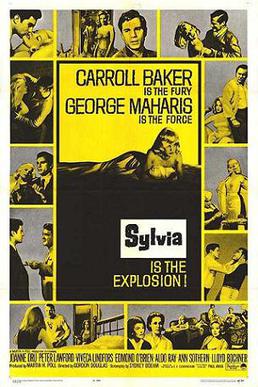
Sylvia is a 1965 American drama film directed by Gordon Douglas, written by Sydney Boehm, and starring George Maharis, Carroll Baker, and Peter Lawford. The film is based on the novel of the same name by E. V. Cunningham in 1960.
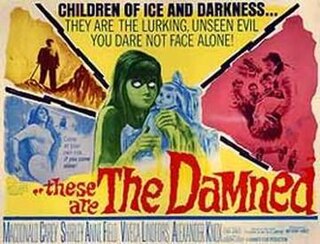
The Damned is a 1961 British science fiction horror film directed by Joseph Losey and starring Macdonald Carey, Shirley Anne Field, Viveca Lindfors and Oliver Reed. Based on H.L. Lawrence's 1960 novel The Children of Light, it was a Hammer Film production.
Sergio Grieco was an Italian film director and screenwriter.

Make Mine Mink is a 1960 British comedy farce film directed by Robert Asher and featuring Terry-Thomas, Athene Seyler, Hattie Jacques and Billie Whitelaw. The screenplay concerns a group of eccentric misfits who go on a crime spree, stealing mink coats for charity in a Robin Hood-style gang. It was based on the play Breath of Spring by Peter Coke, and its sequels. Seyler and Elspeth Duxbury reprised their stage roles from the London production of Breath of Spring.
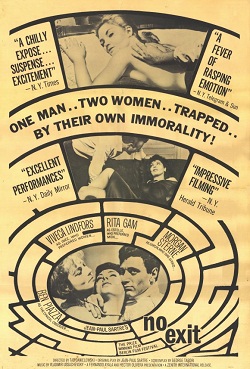
No Exit, also known as Sinners Go to Hell, is a 1962 American-Argentine dramatic film adaptation of Jean-Paul Sartre's play No Exit directed by Tad Danielewski. The film stars Morgan Sterne, Viveca Lindfors and Rita Gam.
I Accuse! is a British 1958 CinemaScope biographical drama film directed by and starring José Ferrer. The film is based on the true story of the Dreyfus affair, in which a Jewish captain in the French Army was falsely accused of treason.

The Story of Ruth is a 1960 American historical romance film directed by Henry Koster, shot in CinemaScope and DeLuxe Color, and released by 20th Century Fox. The screenplay, written by Norman Corwin, is an adaptation of the biblical Book of Ruth. The film stars Stuart Whitman as Boaz, Tom Tryon as Mahlon, Peggy Wood as Naomi, Viveca Lindfors as Eleilat, Jeff Morrow as Tob, and introduces 19-year-old Elana Eden as Ruth.
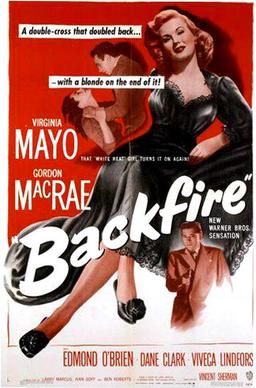
Backfire is a 1950 American film noir crime film directed by Vincent Sherman starring Virginia Mayo and Gordon MacRae, with Edmond O'Brien, Dane Clark, and Viveca Lindfors in support.

The Nights of Lucretia Borgia is a 1959 Italian film. It was also known as Le notti di Lucrezia Borgia and Nights of Temptation. It was one of a series of sexually aggressive characters Belinda Lee played in European movies.

















